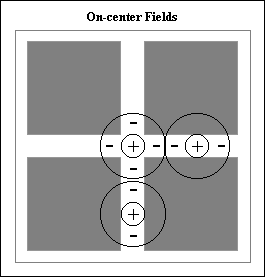The Simultaneous Contrast hypothesis depends on the on- and off-center receptive fields in the retina and the way they are organized and function. Recall that an on-center receptive field is based on ON bipolar cells that depolarize when their associated rod/cone absorbs a photon, while an off-center receptive field is based on OFF bipolar cells that hyperpolarize when their associated rod/cone absorbs a photon.
Since a bipolar cell's electrical behavior causes the same electrical response (depolarization or hyperpolarization) in the ganglion cell with which it synapses, ON bipolar cells cause an ON response (i.e., a burst of action potentials followed by a short lull in action potential generation) from their ganglion cell, while OFF bipolar cells cause an OFF response (a lull in action potential generation by the ganglion cell followed by a short burst of action potentials). ON bipolar cells form the basis of on-center receptive fields, while OFF bipolar cells are the basis for off-center fields.
The next key to understanding the Simultaneous Contrast hypothesis is to recall that when a rod/bipolar cell combination responds to the absorption of a photon, horizontal cells mediate lateral inhibition of surrounding bipolar cells, thereby producing the lateral surround component of the receptive field. Recall that the bipolar and ganglion cells in the lateral surround will exhibit the opposite electrical response to that of the bipolar and ganglion cells in the center of the receptive field. Thus, in the case of an on-center receptive field, the bipolar and ganglion cells in the lateral surround will exhibit an OFF response that accompanies the ON response of the central cells. Similarly, in the case of an off-center receptive field, bipolar and ganglion cells in the lateral surround will exhibit an ON response that accompanies the OFF response of the central cells.
If light is shined on the lateral surround cell tracts, lateral inhibition will cause the bipolar and ganglion cells in the center of the receptive field to exhibit the opposite electrical response to that they exhibit when directly stimulated by light. Thus, light shining on the lateral surround of an on-center receptive field will cause the central cell tracts to produce an OFF response, while light shining on the lateral surround of an off-center receptive field will cause the central cell tracts to produce an ON response
Finally, it appears that the magnitude of the ON or OFF response of a particular receptive field depends on the relative areas of receptive field center and lateral surround being stimulated. If sufficient lateral surround stimulation is occurring, one may observe little or no response from the cell tracts in the receptive field's center.
The Black-squares/white lines illusion
The Simultaneous Contrast hypothesis proposes that the basic Herman grid illusion (black squares, white lines) depends on the function of on-center receptive fields.

In the figure, look first at the concentric circles representing a receptor field centered on one of the intersections of a black square/white line Hermann grid (note that the Simultaneous Contrast hypothesis is based on the assumption that the width of the lines on the Hermann grid produces an image on the retina that is just equal to the diameter of the center of a receptive field). With this alignment, the area of lateral surround cell tracts activated by the white grid lines will be considerably greater than the area of the activated central cell tracts. However, when the receptive fields are aligned with grid lines between the intersections, there will be less activation of the lateral surround. This means that the lateral surround will have less inhibitory effect on the central cell tracts, meaning that there will be a stronger ON signal sent to the brain from on-center fields aligned with the lines than from on-center fields aligned with the intersections. The outcome of this, according to the Simultaneous Contrast hypothesis, is that the intersections will appear darker than the intervening segments of the grid lines, thus producing the illusory spots that we term the Hermann grid illusion.
Questions
1. Can the behavior of on-center fields account for the light spots at the intersections of the white squares/black line version of the Hermann grid? Justify your answer.
2. If you answered "No" to Question #1, can you suggest a mechanism that would account for the light spots at the intersections of the white squares/black line version of the Hermann grid? (Hint: think about off-center receptive fields)
3. Retinal receptive fields are modeled as being concentric circles, i.e., two circles of different diameter sharing a common center, but there's no obvious reason why they would have to be structured thusly. For example, suppose the lateral surround, instead of being a concentric circle, were a long rectangle of the same width as the central part of the receptive field, but extending several times that distance 'above' and 'below' (or to the 'left' and 'right' of the central area of the receptive field. How might that affect the illusion, if at all? Speculate about other arrangements of the receptive fields and try to develop a prediction of how the illusion might appear under each arrangement.